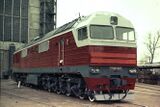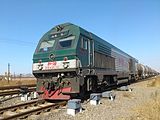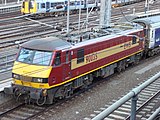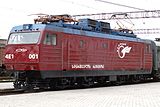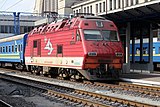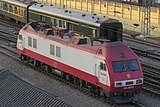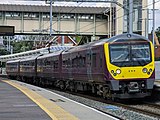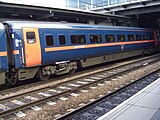Kráľovské Holynské Železnice
Jump to navigation
Jump to search
 | |
| State owned public limited company | |
| Industry | Railways |
| Predecessor | Holyn State Railways (1941-2002) |
| Founded | 10 May 2002 |
| Headquarters | , |
Area served | Holynia |
| Services | Rail transport, Cargo |
| Owner | Holinvestičnéholdingy (Holyn government) (100%) |
Number of employees | 110,000 (2018) |
| Website | Holyn Railways (English) |
Kráľovské Holynské Železnice AS (English: Royal Holyn Railways AS) is the national railway company of Holynia. It is owned by the Holyn government through Holinvestičnéholdingy, receiving annual subsidies. It received the assets of Holyn State Railways in 2002, following the passage of the Railways Act of 2002. It owns and maintains 90% of the railway network in Holynia and operates roughly 70% of the services. Initially holding a monopoly on the railways in Holynia, it now faces competition from the private sector on both passenger and cargo services.
Train categories
Long-distance
- High Speed for high-speed long-distance train services between major cities and regions. One route crosses the border into Movargovina.
- SperoRail for intercity trains that cross Spero borders, and connect Holynia with other countries. Are frequently operated by foreign state railways.
- Holyn Sleeper for night service between major cities and regions in Holynia, and services to international countries operated by KHZ.
- InterCity Express for semi high-speed long-distance train services between major cities and regions. Typically operate at 200 km/h to 220 km/h.
- InterCity for long-distance train services between major cities and regions. Much more frequent than InterCity Express services but make more stops.
- InterRegio for long-distance train services between regions and centers in Holynia. Lower in class than InterCity but more frequent. Makes more stops than InterCity.
- Regional Express for semi-fast regional service making stops within regions in Holynia.
- Regional for regional services making stops within regions in Holynia. Often most basic train available operated by KHZ.
- Suburban for suburban commuter rail services in major cities. KHZ passed these services over to the respective regional transport entity, however, most operate on KHZ trackage.
Rolling stock
Diesel-electric locomotives
| Class | Entered service | Use | Number in service | Power output | Remarks |
|---|---|---|---|---|---|
| 105 | 1970 | General goods/pusher/work trains | 82 | 2,208 kW (2,961 hp) | Will be retired 2025. |
| 106 | 1975 | General goods/bulk cargo/work trains | 567 | 1,472 kW (1,974 hp) | |
| 109 | 1977 | General goods/work trains | 781 | 1,103 kW (1,479 hp) | |
| 110 | 1979 | Yard switcher/local train/work trains | 82 | 2,350 kW (2,150 hp) | |
| 112 | 1980 | General goods/bulk cargo/intermodal | 1,214 | 4,500 kW (6,035 hp) | |
| 114 | 1984 | Yard switcher/local train/work trains | 106 | 3,000 kW (4,000 hp) | |
| 117 | 1989 | General goods/bulk cargo/intermodal | 47 | 2 x 6,000 hp | |
| 120 | 1999 | Passenger trains | 201 | 1,864 kW (2,500 hp) | |
| 121 | 1999 | General goods/bulk cargo/intermodal/work trains | 357 | 2,240 kW (3,000 hp) | Tight loading gauge compliant locomotives |
| 124 | 2005 | General goods/bulk cargo/intermodal/work trains | 406 | 5,000 kW (6,705 hp) total | Typically a married pair of 2 units. |
| 127 | 2007 | General goods/bulk cargo/intermodal/work trains | 61 | 3,184 kW (4,270 hp) | |
| 129 | 2010 | General goods/bulk cargo/intermodal/work trains | 301 | 4,700 kW (6,300 hp) | |
| 130 | 2010 | General goods/bulk cargo/intermodal/work trains | 200 | 9,300 hp | 3 106 married locomotives with cabless "B" unit |
| 132 | 2012 | Passenger trains | 76 | 2,800 kW (3,800 hp) | |
| 133 | 2014 | General goods/bulk cargo/intermodal/work trains | 407 | 2,000 kW (2,700 hp) | |
| 134 | 2015 | General goods/bulk cargo/intermodal/work trains | 975 | 4,660 kW (6,250 hp) |
Diesel-electric freight locomotives
Electric locomotives
| Class | Entered service | Use | Number in service | Remarks |
|---|---|---|---|---|
| 424 | 1977 | Cargo division | 41 | Limited service, expected to be retired by 2023. |
| 429 | 1979 | Cargo division | 82 | |
| 430 | 1980 | Passenger/Cargo divisions | 517 | |
| 431 | 1984 | Passenger/Cargo divisions | 879 | |
| 433 | 1982 | Cargo division | 63 | |
| 435 | 1989 | Passenger division | 81 | Designed to operate with Series 5 coaches. |
| 436 | 1993 | Passenger/Cargo divisions | 50 | |
| 439 | 1996 | Passenger division | 22 | |
| 440 | 2001 | Cargo division | 871 | Married pair designed for heavy haul services |
| 441 | 2002 | Passenger division | 81 | |
| 443 | 2005 | Passenger/Cargo divisions | 137 | |
| 447 | 2006 | Cargo division | 87 | Married pair |
| 449 | 2007 | Cargo division | 1,150 | |
| 450 | 2009 | Cargo division | 622 | Married pair designed for heavy haul services. |
| 452 | 2012 | Passenger/Cargo divisions | 95 | |
| 453 | 2012 | Cargo division | 527 | Second generation of Class 449 |
| 454 | 2014 | Passenger/Cargo divisions | 527 | Second generation of Class 449 |
| 455 | 2015 | Passenger division | 91 | |
| 456 | 2016 | Passenger/Cargo divisions | 762 | Intended to replace older electric locomotives |
Electric locomotives
Diesel multiple units
Electric multiple units
Electric multiple units
Electric multiple units
Passenger cars
Passenger cars






